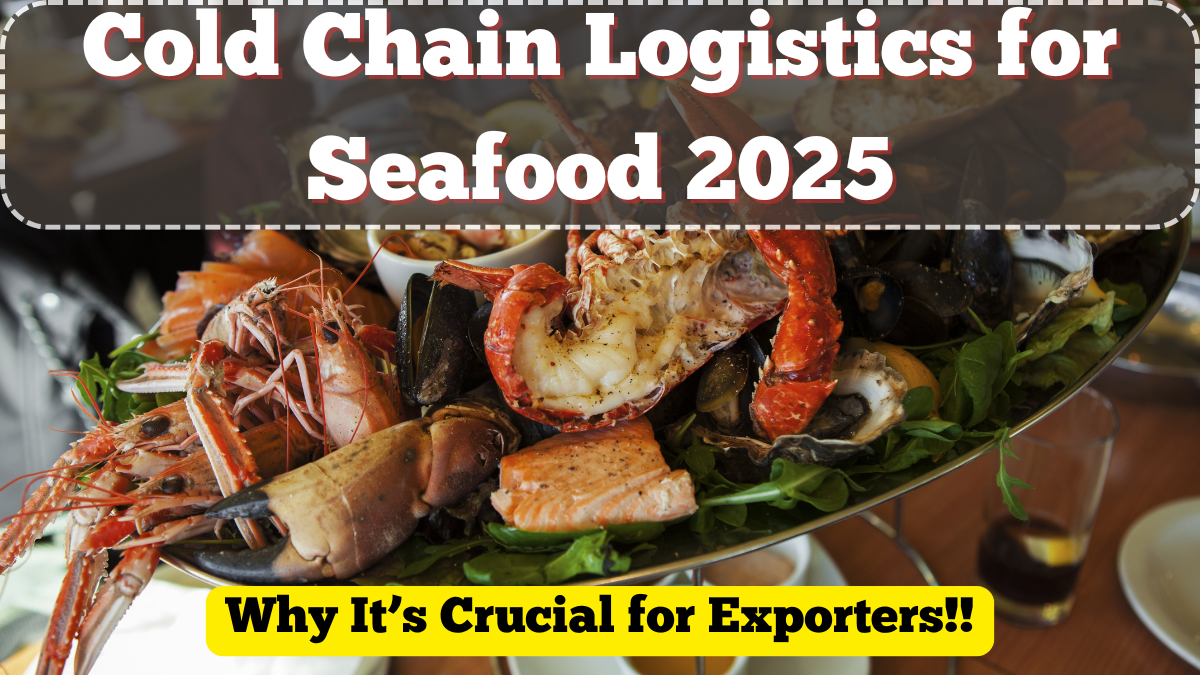In the seafood industry, maintaining the integrity of products from catch to consumer is non-negotiable. That’s why cold chain logistics has become the backbone of India’s seafood export operations in 2025. With international buyers now demanding higher food safety standards and longer shelf life, exporters are investing heavily in modern cold storage, transport, and real-time monitoring solutions.
Improper handling during shipping can lead to spoilage, bacterial contamination, and outright rejection of shipments at international borders. This is especially critical when dealing with sensitive items like frozen shrimp, squid, and cuttlefish. Efficient cold chain logistics is no longer optional — it is now a compliance requirement under the June 2025 fisheries export regulations.
Let’s explore how businesses can strengthen their cold chain systems to stay competitive and compliant.

Why Cold Chain Logistics Is Non-Negotiable in 2025
Proper cold chain logistics ensures that seafood maintains its optimal temperature from the moment it is caught until it reaches its final destination overseas. Here’s why it matters:
-
Preserves product quality by preventing texture degradation and nutrient loss.
-
Meets global hygiene and safety norms enforced by the EU, USA, and Japan.
-
Reduces spoilage and export rejections, saving significant operational costs.
-
Boosts buyer trust and price premiums for compliant, traceable shipments.
As part of India’s Marine Export Development Plan 2025, new rules require continuous temperature monitoring and documentation for all seafood shipments.
Key Components of Cold Chain Logistics for Seafood
To comply with export protocols and maintain product quality, every stakeholder must integrate the following cold chain logistics elements:
-
Insulated Fishing Boats: Vessels must be equipped with ice slurry tanks or refrigerated storage to begin preservation at sea.
-
Processing Plant Chillers: Immediate transfer to chilling systems at <4°C within 2 hours of landing is now mandatory.
-
Blast Freezers & Plate Freezers: Used to rapidly bring the core temperature of seafood to below -18°C before packaging.
-
Refrigerated Trucks: All transportation units must have GPS-linked temperature control and alert systems.
-
Cold Storage Warehouses: Facilities must offer multi-tiered storage zones with humidity and temperature sensors.
These elements work in tandem to form a seamless cold chain logistics system, ensuring compliance and high product integrity.
New Compliance Rules Around Cold Chain in 2025
The June 2025 fisheries guidelines outline strict cold chain rules for all marine exporters:
| Compliance Requirement | Minimum Standard | Monitoring Method |
|---|---|---|
| Storage Temperature | -18°C or below for frozen seafood | Digital Temp Loggers |
| Transport Temperature | ≤ -18°C (Frozen), 0–4°C (Chilled) | Vehicle Tracking Systems |
| Entry-to-exit Temperature Gap | Not to exceed 2°C deviation | RFID and IoT Sensors |
| Audit Frequency | Monthly (Mandatory MPEDA audits) | Digital Audit Records |
| Training | Cold chain handling staff to be certified | FSSAI/MPEDA-accredited programs |
Exporters are being asked to upgrade their systems or face restrictions on high-value international shipments.
Benefits for Exporters Investing in Cold Chain
Firms that have adopted robust cold chain logistics in 2025 are already seeing measurable gains:
-
20% lower product rejection rates in top importing markets.
-
15–25% increase in profitability due to premium pricing.
-
Access to new buyer contracts from Japan, Canada, and the EU.
-
Better shelf life of packaged seafood, enabling longer distribution windows.
Cold chain is not just about compliance anymore—it’s become a growth lever for India’s marine industry.
Government Support for Cold Chain Enhancement
Recognizing the capital-intensive nature of cold chain setup, the government is offering:
-
Capital subsidies under the Marine Infrastructure Upgrade Scheme 2025.
-
Loans at reduced interest rates for refrigerated truck fleets and blast freezers.
-
Free training programs through Fisheries Extension Centers across coastal states.
-
MPEDA’s dedicated Cold Chain Helpline for exporters needing technical guidance.
These initiatives are helping even small and medium enterprises improve their cold chain logistics capabilities and reduce export losses.
FAQs
What is cold chain logistics in seafood export?
Cold chain logistics refers to the temperature-controlled handling, storage, and transportation of seafood to maintain its safety, quality, and compliance from harvest to final delivery.
Why is cold chain important for marine exports?
It ensures the seafood remains fresh, prevents spoilage, and meets international food safety regulations, especially for frozen and chilled items.
What are the required temperatures for seafood exports?
Frozen seafood must be maintained at -18°C or below, and chilled seafood should be kept between 0°C to 4°C throughout the supply chain.
Are there government incentives for cold chain infrastructure?
Yes, the Indian government offers subsidies, low-interest loans, and technical training to help exporters upgrade their cold chain facilities.
What happens if cold chain breaks during shipping?
Shipments may be rejected at ports of entry, leading to significant financial losses, penalties, and potential blacklisting by buyers.
Click here to know more.
